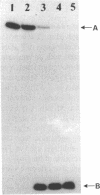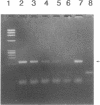Abstract
Cross-contamination with previously amplified products poses a serious limitation in the use of PCR for clinical testing and in certain research applications as well. In the present study we report the use of novel primers containing a 3'-terminal ribose residue to circumvent this problem. Extension of the primer by Taq DNA polymerase generates a cleavable ribonucleotide linkage within the amplified product. Cleavage of the primer by base or with a ribonuclease interferes with further replication of the product should carry over to another sample occur. Primers terminating in any of the 4 ribose residues function equally well as all DNA primers. Taq DNA polymerase is thus able to both efficiently extend and copy the single ribose residue. In translating from all DNA primers to ones containing a 3'-ribose residue no modification of the PCR protocol is required. The products formed can be used in all applications of the PCR. Since neither the original sample DNA, the primers or the extension products are modified by base or ribonuclease treatment both pre- and post-amplification sterilization can be carried out. Pre-amplification treatment with RNase A can yield as high as 10(4)-fold sterilization. Under these conditions the addition of beta-mercaptoethanol or other sulfhydryl reducing agent is necessary to inactivate the enzyme during thermocycling. Post-amplification treatment with NaOH readily yields at least 10(6)-fold sterilization. This alone is sufficient for most, if not all, applications of PCR. It is especially useful for quantitative RT-PCR, since the original target RNA sequence, which may be present in high copy numbers, is also destroyed.
Full text
PDF




Images in this article
Selected References
These references are in PubMed. This may not be the complete list of references from this article.
- Cimino G. D., Metchette K. C., Tessman J. W., Hearst J. E., Isaacs S. T. Post-PCR sterilization: a method to control carryover contamination for the polymerase chain reaction. Nucleic Acids Res. 1991 Jan 11;19(1):99–107. doi: 10.1093/nar/19.1.99. [DOI] [PMC free article] [PubMed] [Google Scholar]
- Isaacs S. T., Tessman J. W., Metchette K. C., Hearst J. E., Cimino G. D. Post-PCR sterilization: development and application to an HIV-1 diagnostic assay. Nucleic Acids Res. 1991 Jan 11;19(1):109–116. doi: 10.1093/nar/19.1.109. [DOI] [PMC free article] [PubMed] [Google Scholar]
- Longo M. C., Berninger M. S., Hartley J. L. Use of uracil DNA glycosylase to control carry-over contamination in polymerase chain reactions. Gene. 1990 Sep 1;93(1):125–128. doi: 10.1016/0378-1119(90)90145-h. [DOI] [PubMed] [Google Scholar]
- Mullis K. B., Faloona F. A. Specific synthesis of DNA in vitro via a polymerase-catalyzed chain reaction. Methods Enzymol. 1987;155:335–350. doi: 10.1016/0076-6879(87)55023-6. [DOI] [PubMed] [Google Scholar]
- Saiki R. K., Gelfand D. H., Stoffel S., Scharf S. J., Higuchi R., Horn G. T., Mullis K. B., Erlich H. A. Primer-directed enzymatic amplification of DNA with a thermostable DNA polymerase. Science. 1988 Jan 29;239(4839):487–491. doi: 10.1126/science.2448875. [DOI] [PubMed] [Google Scholar]
- Zale S. E., Klibanov A. M. Why does ribonuclease irreversibly inactivate at high temperatures? Biochemistry. 1986 Sep 23;25(19):5432–5444. doi: 10.1021/bi00367a014. [DOI] [PubMed] [Google Scholar]







